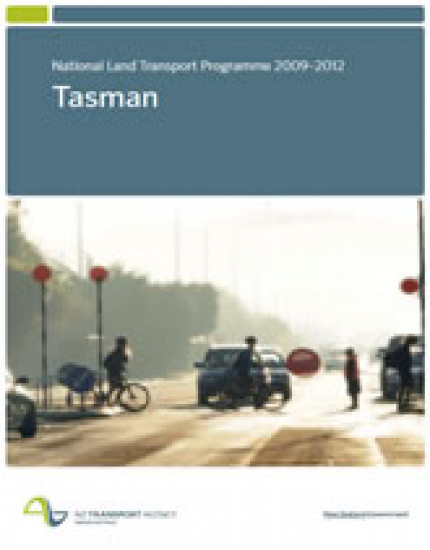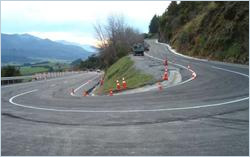The Tasman region currently faces a number of transport-related challenges, including the need to: support continued growth in the primary and tourism sectors by providing a secure and reliable regional roading network; respond to transport demands from rapid population growth, particularly in Richmond; and address a number of safety-related concerns.


I am pleased to introduce to you this National Land Transport Programme (NLTP) for 2009-2012 – a programme through which the NZ Transport Agency (NZTA) is making a record investment in land transport at a time when New Zealand needs it most.
The global economic situation has changed dramatically in the past 18 months, with significant impacts for the New Zealand economy. In response, and as part of its commitment to improving New Zealand's economic outlook and performance, the government has set clear expectations and priorities for the land transport sector. These expectations are articulated in the Government policy statement on land transport funding 2009/10 – 2018/19 (GPS)(external link).
Through this NLTP, the NZTA 'gives effect' to the GPS with a focus on supporting economic activity and employment throughout the country. It aims to deliver the best possible returns for New Zealand, through prioritising a wide range of national and regional activities.
The NLTP demonstrates an increased focus on efficiency and effectiveness in all spending, a rigorous national approach to setting priorities, and an ongoing focus on improving safety and reducing the adverse environmental effects of land transport.
This document details the funding provided for the Tasman region – and as a dynamic document will be reviewed and updated regularly to reflect any approved variations to programmes.
For information on funding for the rest of New Zealand (and how the NLTP is developed and managed) please see the national NLTP document.
The Tasman region currently faces a number of transport-related challenges, including the need to:
In balancing these issues against national investment priorities, the NZTA is committed to ensuring the NTLP represents value for money in all activities and across regions. We've achieved this by developing a robust national prioritisation framework, and ensuring the highest priority projects have first call on available funds.
A strong commitment to value for money has also led to changes in how R (regional) funding is used. R funds come from fuel excise duty and light road user charges and are allocated proportionally to regions based on population. In the past, R funding was often used to fund lower-priority projects that would otherwise not qualify for funding. To ensure value for money, R funds will now be used for the highest priority projects, providing a guaranteed minimum level of funding for each region. However, the effects of this funding change will play out slightly differently in Tasman, because all R funds in the Tasman region are already committed to the Ruby Bay Bypass. This means new Tasman projects in the NLTP will be funded from N (nationally distributed) funds.
The National Land Transport Fund can only be used to fund activities listed in the NLTP. The tables in this NLTP list:
This NLTP provides an investment of $89.7 million for the Tasman region over the 2009/10- 2011/12 period. The NLTP targets investment in three key areas in Tasman, with the aim of helping businesses to increase their productivity:
This investment is critical to ensure we maintain appropriate service levels, improve safety and provide route security on key inter-regional freight and tourist routes. It will also ensure we maintain access to key markets and destinations, including the Port of Nelson.
In the next three years, the Ruby Bay bypass will remain the most substantial element in the region's state highway improvement programme. The bypass will provide a more direct route between Motueka and Nelson, improving safety and efficiency on State Highway (SH) 60. Excellent progress has been made in the past year, with the project on track for completion in 2011/12.
Previous funding commitments also mean that the construction of key walking and cycling projects, such as the Richmond Railway Reserve walking and cycling project, is likely to be completed within the next three years. Bus and total mobility services in Tasman are likely to continue at current levels, with funding allocated to maintain services in key areas.
The need to ensure appropriate planning for Tasman's transport networks has also been recognised with the allocation of approximately $1.1 million to transport planning studies in the next three years. Proposed studies include a forestry harvesting impact study, crash reduction studies and traffic management studies in Richmond and Motueka. This work is important to ensuring the transport networks are best placed to support future opportunities and challenges in the region.
For an overview of significant projects in the region that are likely to receive funding in the next three years, see the regional map.
While the prioritisation process has resulted in most projects in Tasman's regional land transport programme (RLTP) being reflected in this NLTP, some are unlikely to receive funding – including the Richmond to Aniseed and Aniseed to Brightwater cycle projects, and the Eighty Eight and Gibbons Valleys seal extension projects. These projects do not align well with national investment priorities, particularly in activity classes where funding is limited.

For demand management and community programmes, our primary investment focus for 2009/10 is on programmes that deliver on a relevant road safety strategy and achieve a change in travel behaviour that will reduce severe congestion in major urban areas. In addition, for this activity class the NZTA received significantly more funding applications than in the previous year. This, together with the funding available as specified by the GPS and our targeted investment focus for this year, means a reduction on last year funding level.
The NZTA Board has requested a review of the demand management and community programmes activity class to provide evidence of the benefits and value for money that its programmes deliver. Accordingly funding for these programmes is approved for 2009/10 only, with the review expected to establish the funding direction for the subsequent two years.
Our thanks go the Tasman Regional Transport Committee, which has a pivotal role in shaping the region's transport future.
One of the committee's key tasks is to develop Tasman's three-year RLTP, which prioritises all the regional transport activities proposed by the local authority and the NZTA (on work relating to the state highway).
Public submissions on Tasman's draft programme by the Tasman Regional Transport Committee were reflected in the final programme that went to the NZTA Board.
This regional perspective enabled the NZTA Board to build a geographic view of land transport requirements nationwide, and to align regional and national views in deciding on the most appropriate allocations of funds to give effect to the GPS priorities.
The next three years will bring challenging times. The NZTA and Tasman District Council will need to actively manage their programmes to ensure we stay on target and deliver our commitments. I look forward to working with the Tasman Regional Transport Committee and New Zealand Police to implement this NLTP and assist in the continued development of the Tasman region.
Deborah Hume
Regional Director
Last updated: 6 October 2009